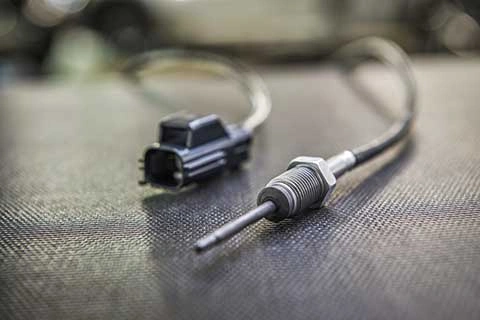YOU ASKED GOOGLE & NGK SPARK PLUG ANSWERS! - PART 6: EXHAUST GAS TEMPERATURE SENSORS

1. What is an exhaust gas temperature sensor (EGTS)?
EGTS measure the temperature in the exhaust pipe. Installed at different positions along the exhaust pipe, the EGTS are used to gather information that is sent to the engine control system (ECU) to ensure protection against overheating and to observe the diesel particle filter (DPF) cleaning.
2. How does the EGTS work?
EGTS are used to monitor the optimum operating point, to protect the relevant components from temperature overload and to keep them in the desired temperature range for optimal conversion rates. EGTS are therefore an important component for the reduction of harmful emissions from vehicles.
EGTS serve as a temperature monitor for turbochargers, catalytic converters, diesel particle filters and nitrogen oxide reduction systems. There are two types of EGTS: Positive Temperature Coefficient (PTC) and Negative Temperature Coefficient (NTC). Resistance in PTC sensors increases with rising temperature, while with NTC sensors, resistance decreases with increasing temperature.
3. How do you test an exhaust gas temperature sensor?
First the EGTS has to be disconnected from the ECU. Then the EGTS has to be connected to a multimeter (in ‘Ohms’ setting) or better still, an oscilloscope. The sensor should then be heated up by running the engine (remember: for NTC sensors, resistance drops with rising temperature; for PTC sensors, the resistance rises with the temperature). Measurement should be taken from the beginning as sensors respond extremely quickly and attention should be paid to see if the resistance drops (or rises) continually (without interruption) with rising temperature. If the sensor is uninstalled, a heating fan can be used to warm it up, while ensuring that the correct measuring range is chosen. Otherwise an ‘open line’ may be displayed, even if the sensor is functioning properly. See question 8 for the correct functioning temperatures of each type of EGTS. The use of caution is advised when working with hot parts and/or when the engine is running.
For further information, the video link: [EN] Exhaust Gas Temperature Sensor testing with Multimeter - YouTube provides useful information.
4. What does the presence of a "p2033" code indicate on an EGTS?
‘p2033’ is a diagnostic trouble code that informs that the EGTS – located in the upstream pipe forward of the catalytic converter circuit – has a high voltage condition. This EGTS performs the role of protecting the catalytic converter from excessive heat damage.
5. Where is the exhaust gas temperature sensor located?
EGTS can be found either upstream or downstream of: 1) the catalytic converter, 2) the turbocharger, or 3) the DPF. EGTS are also used in the components of the NOX reduction system.
6. Can you clean an EGTS sensor?
If there has been a build-up of contaminants on the sensor, it may be possible to clean it. This can be performed with a dry cloth.
7. What are the symptoms of a faulty EGTS?
If an EGTS is faulty, the ‘check engine’ light will be triggered by the ECU. Symptoms of a faulty EGTS include reduced fuel efficiency, failure of other components as well as unsuccessful DPF generation, which can damage the DPF as a consequence.
8. What is the correct functioning temperature for an EGTS?
A properly functioning NTC (Negative Temperature Coefficient) ‘E-Type’ EGTS should display a normal operating temperature range of between 40//+900°C and a resistance between approx. 100Ω - 200kΩ. At room temperature (20°C) it should give a reading of approx. 20kΩ.
A properly functioning NTC ‘C-Type’ EGTS has a normal operating temperature range of between 100//+900°C and a resistance between approx. 100Ω - 200kΩ. At room temperature (20°C) it should give a reading of approx. 6MΩ.
The difference between ‘E-Type’ and ‘C-Type’ EGTS are mainly their measuring elements. They are identified through the presence of the letters ‘E’ and ‘C’ in the part numbers.
A properly functioning PTC (Positive Temperature Coefficient) EGTS temperature detection range is from -70//+900°C. At room temperature (20°C) it should give a reading of approx. 220Ω.








